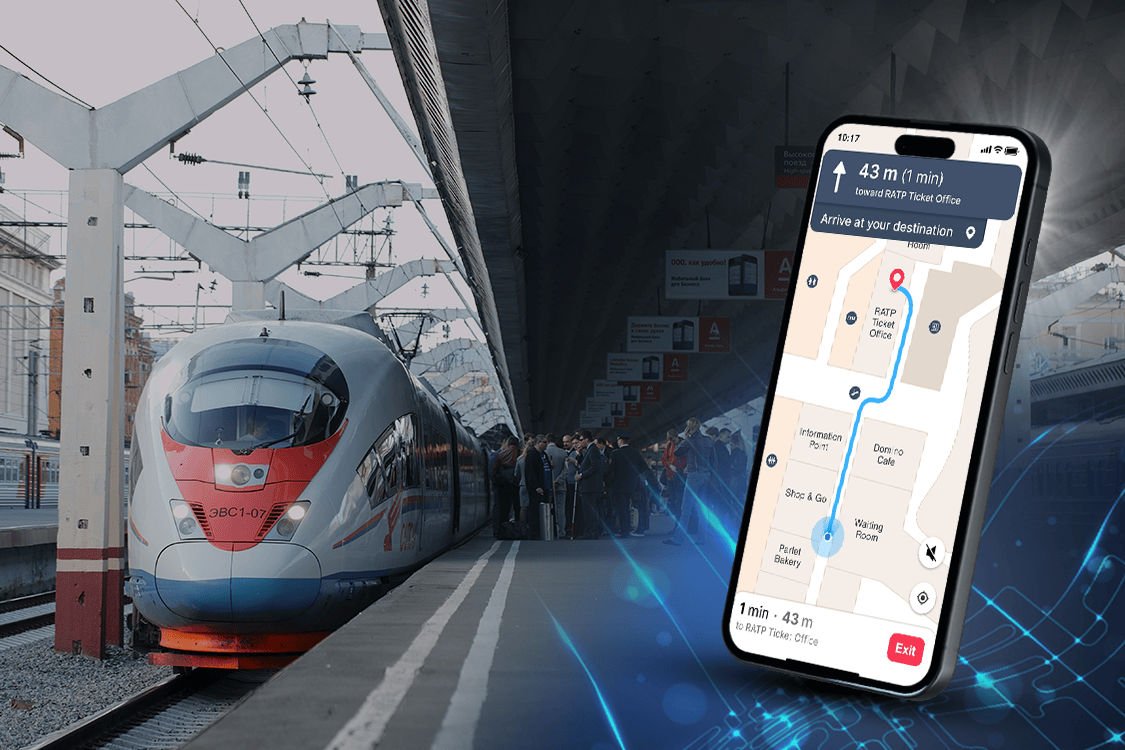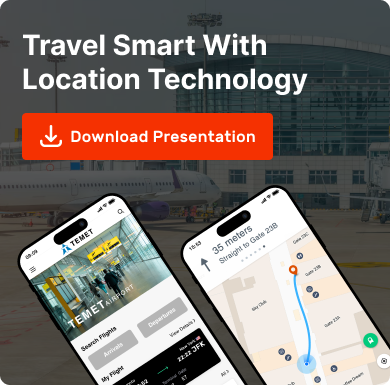Transportation Hubs

When we think about trains and railways, we often picture tracks, engines, stations and maybe even cargo. But what ties all of this together—what keeps trains moving smoothly, stations less chaotic and passenger experience better—is something most people overlook: navigation. Not navigation like GPS on your phone, but smart, real-time navigation systems that guide passengers inside complex railway stations, help operations teams run schedules on time and make the whole network easier to use and manage. This blog breaks down how modern railway navigation systems, the role of navigation in growth of rail economy—they’re critical to the growth of the rail economy.
Why Navigation Matters More Than Ever in Rail
Rail travel is growing. Not just in major metro cities, but across small towns, suburbs and regional hubs. With this growth, the role of navigation in the growth of the rail economy has become more important than ever.
Here’s what’s happening:
- Trains are faster, but stations are more complex.
- More passengers are boarding, but they’re often confused about where to go.
- Freight logistics are expanding, but delays due to poor coordination cost money.


This is where proper navigation comes in. When passengers can find their platforms quickly, logistics staff can track and reroute shipments in real time and operators can use route data to improve scheduling—everything becomes more efficient.
Better navigation = fewer delays, happier passengers, stronger economic impact
📊 Just how big is freight in this equation?
About 93% of U.S. freight rail revenue is generated by six Class I railroad systems, so it also reflects the scope of coordination required as well as the importance of effective navigation systems to facilitate vast freight movements.
How Rail Navigation Directly Impacts the Economy
To understand how navigation links with the rail economy, let’s look at a few everyday examples.
1. Passenger Flow = Station Revenue
Large railway stations aren’t just about catching a train—they’re shopping centers, food courts and commercial zones. But if passengers can’t find shops or exits in time, they won’t spend. Navigation tools guide people efficiently from train to shop to street—making way for real spending.
2. Operational Efficiency = Lower Costs
Navigation isn’t just for travellers. For operators, it means tracking train locations, crew movement, maintenance schedules and freight activity across vast rail networks. All of this leads to rail network optimization, saving millions in fuel, labour and downtime.
3. Real Estate Uplift = Local Development
Well-managed, well-navigated rail hubs increase the value of nearby land. Look at areas around modern rail hubs in Tokyo or Munich—clean routes, smart signs, digital kiosks and connected apps have turned stations into vibrant commercial zones.
Problems That Poor Navigation Creates
If a passenger misses their train because the signage was unclear, that may seem like a small problem. If 1,000 people miss trains across the country every day, that’s a national issue.
Here’s what poor navigation results in:
- Missed connections, especially in interchange stations.
- Unnecessary crowding at escalators or gates.
- Delays in emergencies due to a lack of directional clarity.
- Loss of passenger confidence and preference for road transport.
And in freight, poor rail navigation leads to:
- Idle wagons due to tracking inefficiency.
- Delayed cargo and failed supply chain contracts.
- Higher costs due to underutilized capacity and misrouted containers.
That’s why many rail industry trends today are focused on digital upgrades—especially in the area of navigation and real-time visibility.
Railway Navigation Systems: What’s Involved
When we say “navigation” in a rail context, we mean a lot more than just signs or maps.
A complete Railway Navigation System includes:
- Indoor navigation tools for passengers inside stations.
- Digital signage and real-time platform updates.
- Location tracking for trains, cargo and maintenance vehicles.
- Mobile apps that connect passengers to transport and retail info.
- AI route optimization for dispatchers and control rooms.
These tools turn stations into smart, connected environments—and keep both people and goods moving without chaos.
📈 And it’s a growing market.
The railway telematics market is projected to grow from $4.4 billion in 2023 to $6.32 billion in 2028, driven by increased government initiatives for smart railways and the adoption of location and IoT-based systems.
A Quick Look at What Others Are Doing
Many countries are already leading the way in improving their navigation systems. Let’s look at two examples:
Tokyo, Japan – Seamless Navigation in Shinjuku
Shinjuku Station is the busiest railway station in the world. Without real-time navigation tools, it would be nearly impossible to manage the 3.5 million passengers who pass through it daily. They’ve implemented smart signage, multilingual navigation and indoor maps through station apps—all part of a coordinated navigation strategy.
How Mapsted Helps
While many companies offer navigation solutions, let’s briefly touch on one player—Mapsted—that’s doing something interesting.
Mapsted’s system offers:
- No external hardware needed – No need for beacons or Bluetooth.
- Indoor-outdoor navigation – Perfect for large rail stations.
- Wi-Fi fingerprinting – Helps pinpoint your location inside crowded terminals.
- Custom wayfinding – Helps users with mobility issues or tight schedules.
This means stations can offer a smoother, more accessible experience for everyone without relying on expensive infrastructure upgrades. For example, a station in Toronto used Mapsted’s navigation tech to guide passengers from rail platforms to mall exits, improving both passenger satisfaction and nearby retail sales.
That’s the kind of quiet but impactful change good navigation makes.
The Technology Behind It: More Than Just Maps
Modern navigation inside railway systems uses a blend of:
- Hardware-free location technology
Useful in both outdoor areas and enclosed stations where GPS fails.
- Data analytics + usage patterns
These help rail operators understand traffic flow and plan better.
- Machine learning for prediction
AI predicts passenger surges, bottlenecks and platform load.
- Integration with other modes
Seamless transfers between trains, buses, subways and airports are only possible when navigation systems talk to each other.
This kind of integrated system plays a big role in railway technology advancements, pushing the sector into a more intelligent, connected and passenger-friendly space.
Navigation and the Future of the Rail Economy
So, how exactly does smart navigation feed into the larger rail economy?
Here are five direct ways:
- Boosts daily passenger throughput without needing physical expansion.
Navigation allows better flow, fewer bottlenecks.
- Drives local business revenues.
Travellers guided to nearby food courts, retail and services generate income.
- Reduces missed connections.
Which in turn increases traveller trust and rail usage.
- Improves accessibility.
When everyone, including the elderly and disabled, can move through a station easily, it widens your user base.
- Supports data-driven infrastructure planning.
By analyzing footfall and traffic patterns, governments can decide where to upgrade or build next.
This is the reason why the role of navigation in the growth of the rail economy is much more than just about user experience. It’s a pillar of strategy for rail operators, city planners and governments.
Closing Thoughts
We often look at trains as engines of growth. But it’s the smooth, invisible systems around them that actually make things work.
Navigation is not just an add-on—it’s the nervous system of modern rail. It ties everything together: trains, stations, passengers, cargo, commerce and city development.
Governments investing in rail need to go beyond tracks and engines. The next wave of smart rail infrastructure depends on:
- Better railway navigation systems
- Integrated real-time data
- User-centric tools that simplify the journey
- Rail network optimization backed by technology
- Support for inclusive movement in public transport
By prioritizing smart navigation, we’re not just moving people—we’re moving the rail economy forward, one connected journey at a time. If you found this blog helpful, please read our blog on “Top 3 Reasons Digital Wayfinding Solutions are Needed at Train Stations in 2025” or watch our video on “Get on Track with Mapsted: Simplifying the Train Station Experience for Travelers” to learn more.
Frequently Asked Questions
Q1. What is the role of navigation in the rail economy?
Ans. Navigation helps improve passenger flow, streamline operations and support local business growth around stations.
Q2. How does poor navigation affect railway operations?
Ans. It leads to delays, missed connections, passenger confusion and inefficiency of the freight.
Q3. What are railway navigation systems?
Ans. They involve indoor maps, real-time tracking, digital signage and mobile navigation tools to direct passengers and manage operations.
Q4. How do navigation systems help freight rail?
Ans. They help track cargo more effectively, synchronize rail networks and reduce them to sit idle.
Q5. Is smart navigation cost-effective for stations?
Ans. Yes, it reduces operational costs and boosts commercial returns without large infrastructure upgrades.
